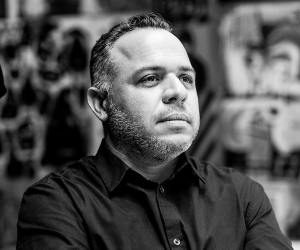From the Series
Edel Rodriguez is one of the top illustrators in the world right now with his work dotting everything from exhibition floors to protest rallies as well as magazine covers. The visual artist dubbed "America's Illustrator-in-chief by Fast Company, has been at the forefront of trying to help Americans, and the rest of the world, make sense of the Donald Trump presidency.
He revealed to Design Indaba that South Africa's history, especially when it comes to protest art, has played a significant role in influencing his approach to his work.
"The struggles of the people of South Africa living under Apartheid, and of Nelson Mandela, are events that I was thoroughly moved by when I arrived in America as a child. I had learned of the stories of Martin Luther King, but South Africa was not history, it was happening in my lifetime. I was only a teenager at the time but followed all the news in the magazines, on the news, and even on MTV, as musicians refused to play South African venues."
He continues: "Thinking of the graphics and posters of that time gives me chills, and honestly, brings tears to my adult eyes. The strong, bold, and graphic black fists, the chains, the bold words of resistance — these posters embodied the dignity of the people and the justice they sought. And that's what I try to do with my work now every day."
He then shares the image below to illustrate some of the work he was influenced by:
When American author and journalist Michael Wolff published his hotly anticipated Donald Trump expose, Fire and Fury: Inside the Trump White House recently, the book’s bland, uninspired cover art was considerably less explosive than its contents.
Rodriguez – who has a noted history of creating irreverent, illustrated depictions of the controversial US President – responded with his own version of the cover that is decidedly more blunt in its characterisation.
Depicting Trump as an enormous cartoon flame threatening to completely engulf both the White House and Washington’s Capitol Building, Rodriguez used mainly shades of orange and yellow – a cheeky nod to his subject’s infamous tinged skin and lightly coloured coiff. An open, seemingly bellowing mouth completes the image, calling to mind the loud and divisive rhetoric that has emerged from the man’s lips since he began his run for the US presidency in 2016.

In a 2017 op-ed for The Washington Post, Rodriguez, who immigrated to the United States with his family as a child, admits to, these days, straining to differentiate his adoptive country from the dictatorship he fled in the eighties. This has led to the artist’s creation of a string of politically relevant work, much of which focuses upon the tangible shift in the political landscape that was ushered in by Trump’s win and the subsequent rise of white nationalism across the globe.
A US citizen since he was nineteen years old, he was a beneficiary of the kind of freedom the nation promises its refugees when, after graduating with an M.F.A. from Hunter College, he became the Art Director for Time Magazine – the youngest to work on the publication’s Canadian and Latin American editions.
Though Rodriguez left the magazine in 2008, his name once again became synonymous with Time due to his creation of three covers in 2016, 2017 and 2018; one depicts Trump having what can only be described as a ‘literal meltdown’, another sees a protester giving a Nazi salute while draped in an American flag, and his latest is stylistically similar to his version of the Fire and Fury cover, with flames engulfing the president’s head.

“I began making art about what I saw, to bear witness,” he wrote in The Washington Post. “I wanted to hold up a mirror to the president’s daily abuses of the Constitution, test the rights given to me by that Constitution. I wanted to find out if this is really the land of the free, the home of the brave.”
A speaker at this year’s Design Indaba Conference, Rodriguez also exhibited some of his work as part of the festivities at this year's conference.
More on graphic design and conceptual illustration:
Jacque Njeri’s vibrant graphic art reimagines the Maasai people in outer space
Lance Wyman on the power of graphic design to transcend language barriers
Cinismo Ilustrado: Illustrated Cynicism
Nigerian writer Ziki Nelson is crowdsourcing a comic book featuring 15 African artists









